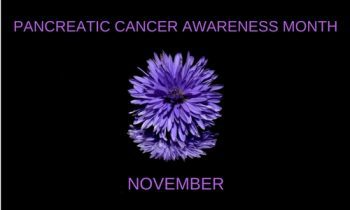
A MONTH FOR PURPLE
Welcome everyone. It’s another #Factual Friday and since November is PANCREATIC CANCER AWARENESS MONTH we’re going to discuss this tricky and somewhat elusive cancer that affects over 60,000 people in this country each year.
Now, pancreatic cancer is the tenth most common cancer among men and women. It strikes men more often than women at an average age of 70. It’s also what I call a “silent cancer” which means that it often remains asymptomatic and undiagnosed until it is more advanced. And this, of course, is a great disadvantage because early detection is our greatest ally in successfully treating any cancer.
But, if we understand these FIVE MAJOR RISK FACTORS we’ll give ourselves a big head-start in protection:
- SMOKING. Remember, tobacco use of every kind has been linked to almost every type of cancer, including pancreatic cancer. The harmful chemicals found in tobacco products are absorbed into the body through the mouth, nose and lungs – and it doesn’t matter if the tobacco is smoked, sniffed, inhaled second-hand or chewed.
- ENVIRONMENTAL CONDITIONS. The workplace appears to play an important part in the development of this cancer. Exposure to petroleum and chemicals found in leather tanning, laboratories, auto mechanics and photographic manufacturing increase one’s risk.
- OBESITY. A diet high in fatty foods not only adds unnecessary weight, but it forces the endocrine system to work harder in order to digest the increased amount of carbohydrates and fat, which may overload the pancreas and its ability to process food properly.
- FAMILY MEDICAL HISTORY. As with many cancers, heredity is so important in our risk for this cancer. If your family history includes Lynch syndrome, von Hippel-Lindau syndrome, Peutz-Jeghers syndrome, cirrhosis of the liver, hereditary breast and ovarian cancer syndrome, familial atypical multiple mole melanoma syndrome (FAMMM) or hereditary nonpolyposis colon cancer (HNPCC) your risk may increase.
- PERSONAL MEDICAL HISTORY. Individuals with a history of diabetes mellitus and chronic pancreatitis may share a greater risk for pancreatic cancer.
And now, armed with knowledge of the major risks of pancreatic cancer, let’s discuss FIVE IMPORTANT SYMPTOMS of the disease:
- NON-SPECIFIC WEIGHT LOSS. Here we’re talking about a sudden and unexplained weight loss of twenty pounds or more.
- LOSS OF APPETITE. Going hand in hand with weight loss, a continued loss of appetite over an extended period of time should always be investigated.
- PAIN IN THE ABDOMEN OR BACK. Physical exercise and exertion can explain pain in the upper abdomen and back. But, pain that continues without explanation should always be reported to your physician.
- DARK URINE. Of course, medications, certain foods and even a harmless and temporary presence of blood in the urine can make it appear darker than normal. It also, however, can be related to more serious conditions, including pancreatic cancer.
- JAUNDICE. This term comes from the French word for yellow, which is jaune. Also known as icterus, this yellowish pigmentation of the skin and whites of the eyes may indicate the presence of pancreatic cancer.
And, there we have it. Once again, understanding the risks and symptoms of any cancer will arm us with the proper tools we need to Take Charge of and be Pro-Active in our personal health care. For if we can’t prevent cancer entirely, we need to do all we can to detect it early and treat it successfully.
This is a cancer that has affected my family and me personally. So, in honor of PANCREATIC CANCER AWARENESS MONTH, please take a little time to research your family medical history. Combine that with your own medical history and lifestyle. Then take the necessary steps to eliminate or modify your personal risk for this particular cancer.
Thanks again for joining me everyone. Until next time, stay in GOOD HEALTH and . . .
TAKE THE COURSE AND TAKE CHARGE!



Leave a Comment